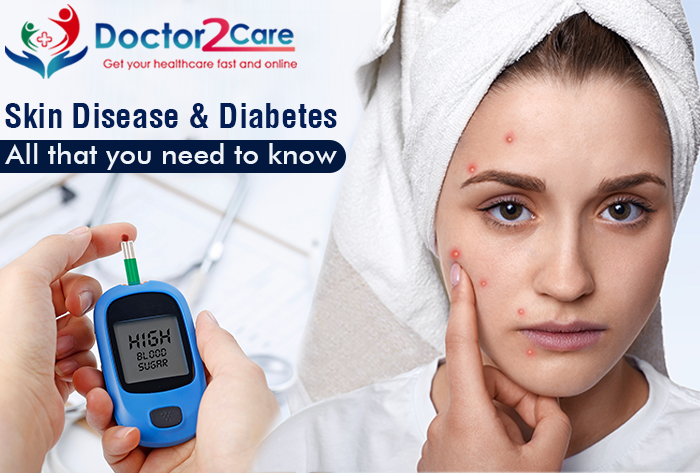Skin Disease and Diabetes - All that You Need to Know

Diabetes has become a common disease, regardless of age. It takes place when the glucose level or the blood sugar level in our body gets high. Diabetes can become life-threatening if the symptoms are not addressed on time. This is why it is important to consult with the best homoeopathy doctor online or a diabetic specialist to seek proper treatment.
It is essential to understand that people who have diabetes are at a much higher risk of developing life-threatening diseases including painful skin disorders. Diabetes affects several parts of your body, including the skin and hair. If the blood sugar level gets out of control, patients suffer from discolouration or even skin rashes. The condition can go away as soon as the blood sugar gets under control.
People with itchy or dry skin, rashes, irritation and other skin conditions are more likely to be suffering from diabetes. Upon noticing changes in your skin, it is important to seek medical treatment on time for proper diagnosis.
Types of diabetes-induced skin diseases
- Diabetic dermopathy is an impact of diabetes and occurs as the scaly brown patches on the skin. These patches are unlikely to hurt and may look oval or circular. Besides, they do not cause any pain or trouble to the patient and are usually harmless.
- Digital sclerosis is the thick and wavy skin developed at the back of the hand, toes, and forehead. It is more likely to occur in patients with type 1 diabetes. This disease affects the joints of the fingers, which becomes stiff and tight, thus reducing movement.
- Necrobiosis Lipoidica Diabeticorum (NLD) occurs when there are changes in the blood vessel. In NLD, the spots are similar to the Bullous Diabeticorum but are more extensive, deeper, and less numerous. The first symptoms of this disease include reddish and dull areas on the skin, which gets shiny after some time. These spots are quite painful and also can crack open in some instances. NLD is quite a rare condition and affects adult women mostly.
- Acanthosis Nigricans - As per the leading diabetic doctors, this disease usually affects people who are overweight or obese. In Acanthosis Nigricans, brown areas or tan (discolouration) appears on the sides of the neck and the armpits. Many patients also notice such spots near the elbows, knees and hands. The leading doctors claim that one of the most effective ways to deal with this condition is to maintain weight, a healthy and balanced lifestyle.
- Bullous Diabeticorum - In standard terms, this condition is also known as diabetic blisters. Bullous Diabeticorum usually occurs at the back of the hands, feet, fingers and at times on the legs and forearms. The blisters often resemble burns and occur in patients dealing with diabetic neuropathy. They are usually large but painless and heal within a few weeks.
In addition to the above, there are several other skin disorders that may be triggered by diabetes. However, if your skin behaves abnormally but you are not diagnosed with diabetes, it may also indicate that there is some issue beginning with the blood sugar levels. If otherwise, you should opt for the best online dermatologist consultation to understand your symptoms.
Steps to take care and prevent diabetes-induced skin diseases
The first and foremost step to prevent diabetes-induced skin disease is to keep your blood sugar levels in check. Along with maintaining your diabetes level, the other steps that you can follow to reduce the chances of skin infection, such as -
- Mild warm water and most arising soap can be pretty soothing on rashes or sores
- Check for the signs of diseases such as redness, rashes or sores regularly and get in touch with the doctor if you see any abnormalities
- After a warm shower, use fragrance-free moisturisers
- Choose creams that retain moisture and hydrate the skin
- For cracked and dry heels, you can use creams with 10% to 25% urea
- Adding a humidifier in your room can increase the monster content of the air
- Keep your body hydrated with enough fluids
- After a shower, does not rub your skin. Pat dry to prevent injuries or friction.
- Treat a cut or a wound immediately. Make use of antibiotic ointments recommended by a specialist.
- In case your wound does not heal, get yourself tested for diabetes
In addition to the above, you should be in constant touch with a diabetic specialist online or offline as suitable to understand your symptoms and treat them accordingly.
Keeping the current scenario in mind, online consultations can help combat the spread of the coronavirus. You can register on platforms like Doctor2Care to contact the top doctors from hospitals and seek professional diabetes treatment.
With a smooth consultation experience, Doctor2Care also lends you 100% private and secured consultations, covid consultations, easy document management and cloud storage.
So what are you waiting for?
If you notice symptoms of diabetes, get in touch with the diabetic specialist on Doctor2Care today.